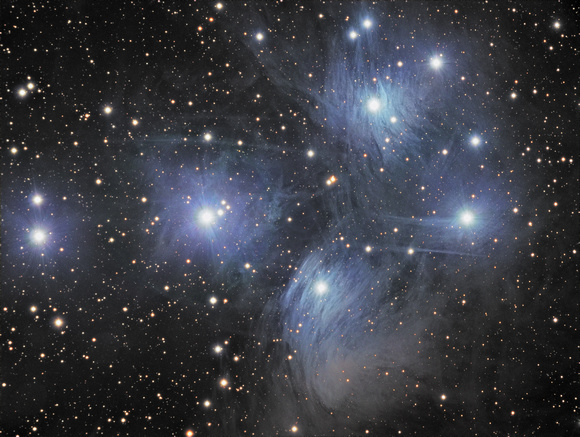APM/TMB 130/780
Field Flattener
QSI 583WSG
Astrodon Gen 2 LRGB
L: 12x10min (1x1)
RGB: 6x5min each (2x2)
Imager Temp -20CFull FrameLink to Larger JPEG The
Pleiades (
M45,
Seven Sisters,
Seven Stars,
Matariki (
New Zealand Maori),
Subaru (
Japan), and perhaps a score of lost and ancient names) is arguably the night sky feature that is the best known and most most deeply entrenched in human
mythology and the human psyche.
This object is known to virtually all human cultures and societies and carries some
significance in all of them.
Unavoidably, when such a prominent and universal icon as the Pleiades has an influence on humanity, there will be those on the fringe that choose to
mystify it. There is even a
society that believes that some
groups of humans carry genes from a race of extraterrestrials originating in the Pleiades.
Astronomically, the cluster is 13 light years across, contains 3000 stars and is about 400 light years distant (among the closest open clusters to earth). It is engulfed in cold, non-excited dust which reflects the bright, blue light from the young hot stars that dominate.
The cluster is dominated by hot
blue stars, which have formed within the last 100 million years. Dust that forms faint
reflection nebulosity around the brightest stars was thought at first to be left over from the formation of the cluster but is now known to be an unrelated dust cloud that the stars are currently passing through. Many objects have been cataloged in this
busy region.
Astronomers estimate that the cluster will survive for about another 250 million years, when it will have dispersed due to gravitational interactions with the
spiral arms of the
galaxy and
giant molecular clouds.
October 8, 2010


